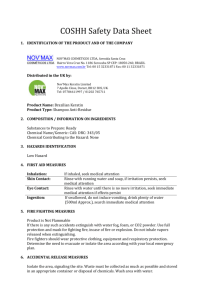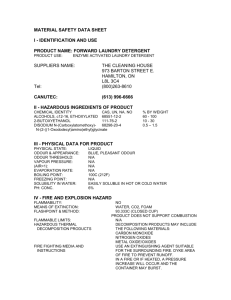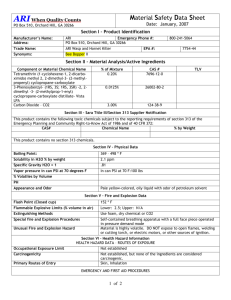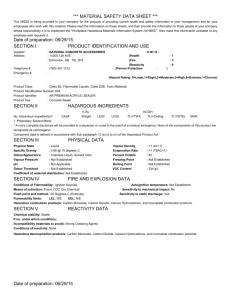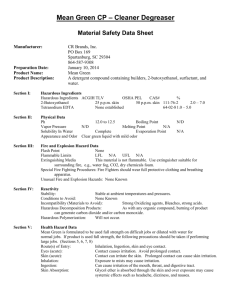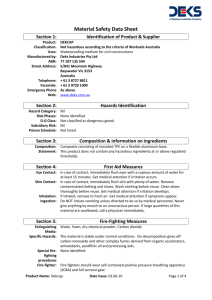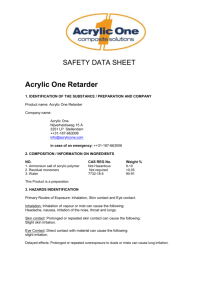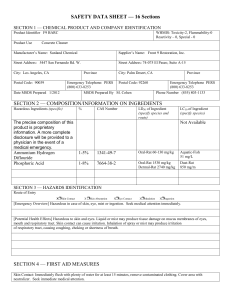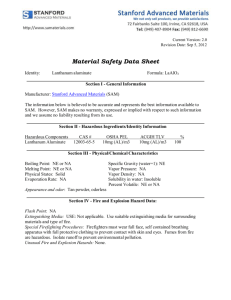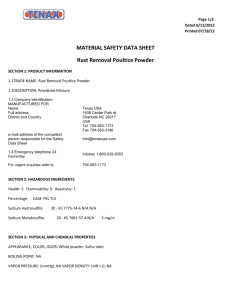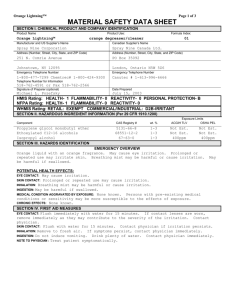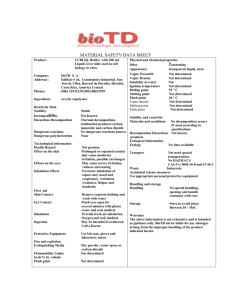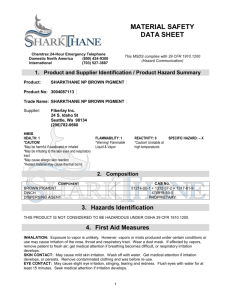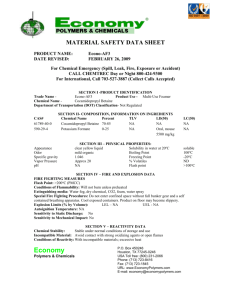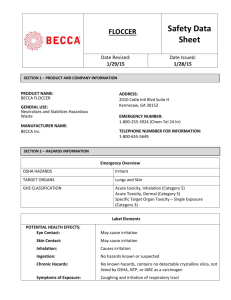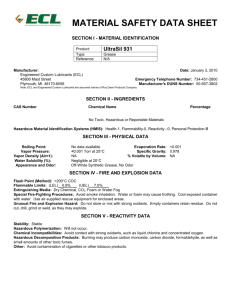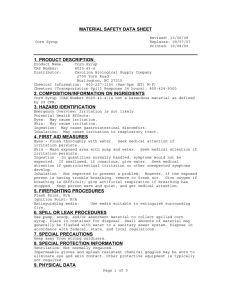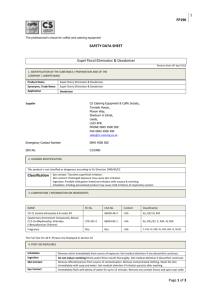Flush 14-133 - Design Chemicals Corporation
advertisement
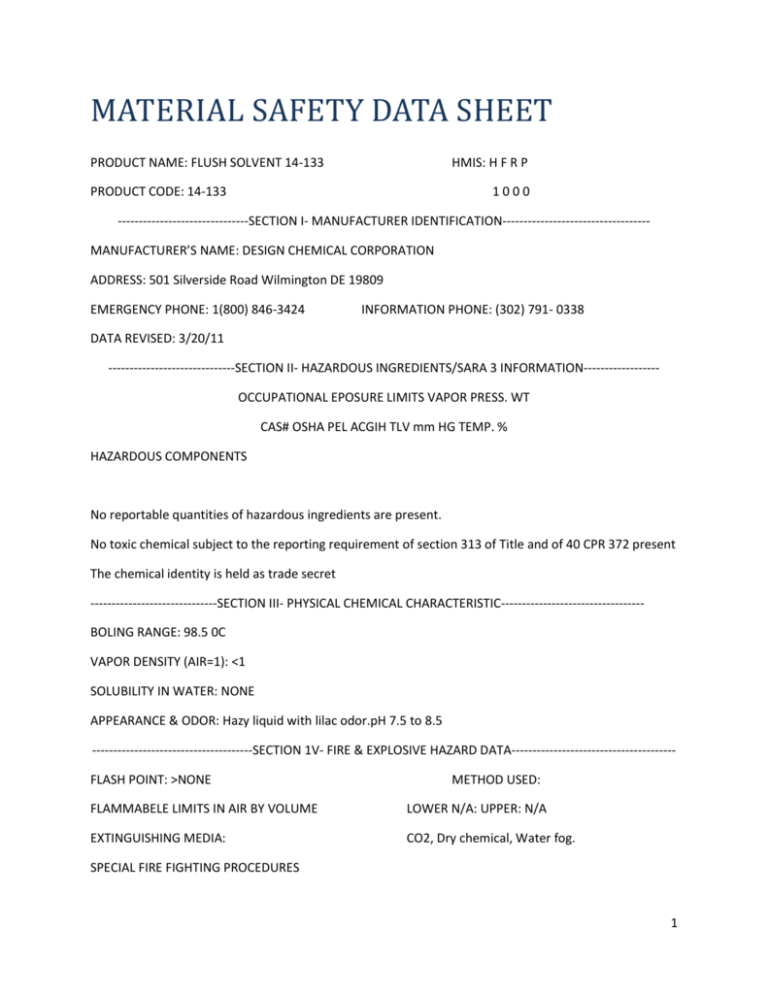
MATERIAL SAFETY DATA SHEET PRODUCT NAME: FLUSH SOLVENT 14-133 HMIS: H F R P PRODUCT CODE: 14-133 1000 -------------------------------SECTION I- MANUFACTURER IDENTIFICATION----------------------------------MANUFACTURER’S NAME: DESIGN CHEMICAL CORPORATION ADDRESS: 501 Silverside Road Wilmington DE 19809 EMERGENCY PHONE: 1(800) 846-3424 INFORMATION PHONE: (302) 791- 0338 DATA REVISED: 3/20/11 ------------------------------SECTION II- HAZARDOUS INGREDIENTS/SARA 3 INFORMATION-----------------OCCUPATIONAL EPOSURE LIMITS VAPOR PRESS. WT CAS# OSHA PEL ACGIH TLV mm HG TEMP. % HAZARDOUS COMPONENTS No reportable quantities of hazardous ingredients are present. No toxic chemical subject to the reporting requirement of section 313 of Title and of 40 CPR 372 present The chemical identity is held as trade secret ------------------------------SECTION III- PHYSICAL CHEMICAL CHARACTERISTIC---------------------------------BOLING RANGE: 98.5 0C VAPOR DENSITY (AIR=1): <1 SOLUBILITY IN WATER: NONE APPEARANCE & ODOR: Hazy liquid with lilac odor.pH 7.5 to 8.5 --------------------------------------SECTION 1V- FIRE & EXPLOSIVE HAZARD DATA--------------------------------------FLASH POINT: >NONE METHOD USED: FLAMMABELE LIMITS IN AIR BY VOLUME LOWER N/A: UPPER: N/A EXTINGUISHING MEDIA: CO2, Dry chemical, Water fog. SPECIAL FIRE FIGHTING PROCEDURES 1 Use blanket or smothering effect to pit out the fire Water is most effective when used as a mist or spray. (Class B fire procedures) UNUSUAL FIRE & EXPLOSIVE HAZARDS: NONE STABILITY Stable at room temperature. LNCOMPATIBILITY (MATERIALS TO AVOID): Strong Oxidizing agents. HAZARDOUS DECOMPOSITION OR BYPRODUCTS: None expected other than normal products of combustion like carbon dioxide and carbon monoxide. HAZARDOUS POLYMERIZATION: Product will not undergo polymerization. _____________________SECTION VI – HEALTH HAZARD DATA _____________________________ IHALATION HEALTH RISKS AND SYMPTOMS OF EXPOSURE: No evidence of inhalation, skin or eye irritation. SKIN & EYE CONTACT HEALTH RISKS AND SYMTOMS OF EXPOSURE SKIN CONTACT: Prolonged or repeated skin contact can cause redness, irritation and scaling of the skin (dermatitis). EYE CONTACT: Direct contact with material can cause stinging and burning. INHALATION: May cause irritation of mucous membranes. MEDICAL CONDITIONS GENERALLY AGGRAVATED BY EXPOSURE None Known. EFFECTS OF OVEREXPOSURE: ACUTE EXPOSURE: None known. SWALLOWING: May cause irritation to the digestive system. SKIN CONTACT: May cause irritation or dermatitis. INHALATION: May cause irritation of mucous membranes. EYE CONTACT: May cause burning sensation. EMERGENCY AND FIRST AID PROCEDURES 2 INHALATION: Move subject to fresh air, if not breathing give artificial respiration. If breathing is difficult, give oxygen. Contact a physician. INDESTION: Do not induce vomiting. Seek medical attention. SKIN CONTACT: Remove contaminated clothes.Thorouly was affected area with soap and water. Use skin cream if irritation is severe. Consult a physician if irritation persists. EYE: Immediately flush with plenty of water for 15 minutes. Call a physician if irritation persists. ------------SECTION V11- PRECAUTIONS FOR SAFE HANDLING AND USE-------------------------STEPS TO BE TAKEN IN CASE MATERIAL IS SPILLED: Absorb material with inert material, then place in chemical waste container. Dilute spills on ground or porous surface with water. For large spills, like for disposal observe government regulation. WASTE DISPOSAL METHOD: Incinerate or use biological treatment in accordance with federal, state and local regulation. DISCLAIMER: This information contained herein is based on data considered accurate. However, no warranty is expressed or implied regarding the accuracy of these data or results to be obtained from the use thereof. We assume no responsibility for any loss damage or expense direct or implied arising from the use of this material. 3



